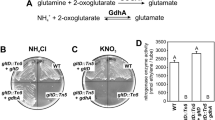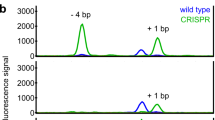Abstract
It has been reported that certain species of free-living Rhizobium were capable of producing nitrogenase1–5, thereby demonstrating conclusively that the nif genes reside in the bacterial component of the dinitrogen-fixing symbiosis between Rhizobium and leguminous host plants. In the comparable dinitrogen-fixing symbiosis between the actinomycete Frankia and the actinorhizal woody dicotyledons that serve as nodulated host plants, the endophytic filamentous bacteria have only recently been brought into culture6–8. We report here evidence that free-living Frankia sp. grown in appropriate nutrient conditions show nitrogenase activity (acetylene reduction) associated with a distinctive morphological structure formed in effective nodules and also developed in culture.
This is a preview of subscription content, access via your institution
Access options
Subscribe to this journal
Receive 51 print issues and online access
$199.00 per year
only $3.90 per issue
Buy this article
- Purchase on Springer Link
- Instant access to full article PDF
Prices may be subject to local taxes which are calculated during checkout
Similar content being viewed by others
References
Keister, D. L. J. Bacteriol 123, 1265–1268 (1975).
Kurz, W. G. W. & LaRue, T. A. Nature 256, 407–408 (1975).
McComb, J. A., Elliot, J. & Dilworth, M. J. Nature 256, 409–410 (1975).
Pagan, J. D., Child, J. J., Scowcroft, W. & Gibson, A. H. Nature 256, 406–407 (1975).
Tjepkema, J. & Evans, H. J. Biochem. biophys. Res. Commun. 65, 625–628 (1975).
Callaham, D., Del Tredici, P. & Torrey, J. G. Science 199, 899–902 (1978).
Berry, A. & Torrey, J. G. in Symbiotic Nitrogen Fixation in the Management of Temperate Forests (eds Gordon, J. C., Wheeler, C. T. & Perry, D. E.) 69–83 (Oregon State University Press, 1979).
Baker, D., Torrey, J. G. & Kidd, G. H. Nature 281, 76–78 (1979).
Newcomb, W., Callaham, D., Torrey, J. G. & Peterson, R. L. Bot. Gaz. 140, Suppl. S22–S34 (1979).
Pommer, E. Ber. dt. bot. Ges. 72, 138–150 (1959).
Lalonde, M. & Calvert, H. E. in Symbiotic Nitrogen Fixation in the Management of Temperate Forests (eds Gordon, J. C., Wheeler, C. T. & Perry, D. E.) 95–110 (Oregon State University Press, 1979).
Burris, R. H. in The Biology of Nitrogen Fixation (ed. Quispel. A.) 9–33 (North-Holland, Amsterdam, 1974).
Benson, D. R., Arp, D. J. & Burris, R. H. Science 205, 688–689 (1979).
Akkermans, A. D. L. thesis, University of Leiden (1971).
Becking, J. H. in Recent Developments in Nitrogen Fixation (eds Newton, W., Postgate, J. R. & Rodriguez-Barrueco, C.) 551–567 (Academic, London, 1977).
Mian, S., Bond, G. & Rodriguez-Barrueco, C. Proc. R. Soc. B194, 285–293 (1976).
Mian, S. & Bond, G. New Phytol. 80, 187–192 (1979).
Baker, D., Newcomb, W. & Torrey, J. G. Can. J. Microbiol. (in the press).
Author information
Authors and Affiliations
Rights and permissions
About this article
Cite this article
Tjepkema, J., Ormerod, W. & Torrey, J. Vesicle formation and acetylene reduction activity in Frankia sp. CPI1 cultured in defined nutrient media. Nature 287, 633–635 (1980). https://doi.org/10.1038/287633a0
Received:
Accepted:
Issue Date:
DOI: https://doi.org/10.1038/287633a0
This article is cited by
-
Tolerance to environmental stress by the nitrogen-fixing actinobacterium Frankia and its role in actinorhizal plants adaptation
Symbiosis (2016)
-
Cultivating the uncultured: growing the recalcitrant cluster-2 Frankia strains
Scientific Reports (2015)
-
A brief history of Frankia and actinorhizal plants meetings
Journal of Biosciences (2013)
-
Alteration of the exopolysaccharide production and the transcriptional profile of free-living Frankia strain CcI3 under nitrogen-fixing conditions
Applied Microbiology and Biotechnology (2013)
Comments
By submitting a comment you agree to abide by our Terms and Community Guidelines. If you find something abusive or that does not comply with our terms or guidelines please flag it as inappropriate.



